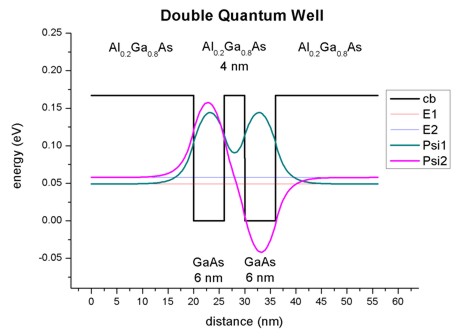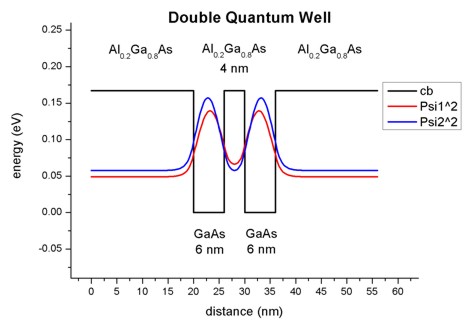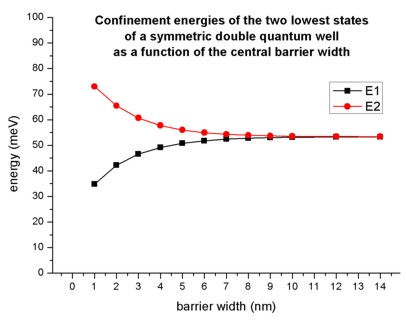— FREE — Double Quantum Well¶
- Input files:
DoubleQuantumWell_6_nm_nnpp.in
DoubleQuantumWell_6_nm_nn3.in
This tutorial calculates the energy eigenstates of a double quantum well. This aims to reproduce two figures (Figs. 3.16, 3.17, p. 92) of Paul Harrison’s excellent book “Quantum Wells, Wires and Dots” (Section 3.9 “The Double Quantum Well”), thus the following description is based on the explanations made therein. We are grateful that the book comes along with a CD so that we were able to look up the relevant material parameters and to check the results for consistency.
Input files for both the nextnano++ and nextnano³ tools are available.
To generate the input files for various thicknesses and some of the plots the following nextnanomat features are used:
It is recommended to read the documentation about these features of the graphical user interface nextnanomat before starting this tutorial.
Structure: AlGaAs / 6 nm GaAs / AlGaAs / 6 nm AlGaAs / AlGaAs¶
Our symmetric double quantum well consists of two 6 nm GaAs quantum wells, separated by a Al0.2 Ga0.8 As barrier and surrounded by 20 nm Al0.2 Ga0.8 As barriers on each side. We thus have the following layer sequence: 20 nm Al0.2 Ga0.8 As / 6 nm GaAs / Al0.2 Ga0.8 As / 6 nm GaAs / 20 nm Al0.2 Ga0.8 As. (The barriers are printed in bold.)
In this tutorial, we demonstrate the following two examples:
we set the thickness of the Al0.2 Ga0.8 As barrier that separates the two quantum wells 4 nm and calculate the lowest two eigenstates.
we vary the thickness of the barrier layer from 1 nm to 14 nm fixing the width of the quantum well (6 nm). Then we calculate the lowest two eigenstates for each case and see the barrier-width dependency of their eigenenergies.
We also explain where the relevant output files are in.
Material Parameters¶
The material parameters are given in database_nn*.in but we can also redefine them manually in input files.
In this tutorial, we redefine parameters so that they are the same as the section 3.9 of Paul Harrison’s book “Quantum Wells, Wires and Dots”.
conduction band offset |
Al0.2 Ga0.52 As / GaAs |
0.167 eV |
conduction band effective mass |
Al0.2 Ga0.52 As |
0.084 m0 |
conduction band effective mass |
GaAs |
0.067 m0 |
Results¶
1. barrier width = 4 nm¶
The following figure shows the conduction band edge and wave functions that are confined inside the wells with barrier width = 4 nm.
(Note that the energies were shifted so that the conduction band edge of GaAs equals 0 eV.)

The wave functions form a symmetric and an anti-symmetric pair. The symmetric one is lower in energy than the anti-symmetric one. The plot is in excellent agreement with Fig. 3.17 (page 92) of Paul Harrison’s book “Quantum Wells, Wires and Dots”.
For comparison, the following figure shows for the same structure as above, the square of the wave function rather than \(\psi\) only.

Output¶
The conduction band edge of the Gamma conduction band can be found here:
bias_00000/bandedge_Gamma.dat (nextnano++)band_structure/cb_Gamma.dat (nextnano³)This file contains the eigenenergies of the two lowest eigenstates. The units are [eV].
bias_00000/Quantum/wf_energy_spectrum_quantum_region_Gamma_0000.dat (nextnano++)Schroedinger_1band/ev_cb1_sg1_deg1.dat (nextnano³)These are the comparison of eigenvalues:
Harrison’s book |
|||
ground state energy [eV] |
0.04920 |
0.04920 |
0.04912 |
first excited state energy [eV] |
0.05779 |
0.05779 |
0.05770 |
This file contains the eigenenergies and the wave functions (\(\psi\)):
bias_00000/Quantum/wf_amplitudes_shift_quantum_region_Gamma_0000.dat (nextnano++)Schroedinger_1band/cb1_sg1_deg1_psi_shift.dat (nextnano³)This file contains the eigenenergies and the squared wave functions (\(\psi ^2\)):
bias_00000/Quantum/wf_probabilities_shift_quantum_region_Gamma_0000.dat (nextnano++)Schroedinger_1band/cb1_sg1_deg1_psi_squared_shift.dat (nextnano³)The subscript
_shiftindicates that \(\psi ^2\) and \(\psi\) are shifted by the corresponding energy levels.
and c. can be used to plot the data as shown in the figures above.
2. barrier width = 1 ~ 14 nm¶
Here, we varied the thickness of the Al0.2 Ga0.8 As barrier layer from 1 nm to 14 nm fixing the width of the quantum well (6 nm). We calculated the lowest two eigenstates and show their eigenvalues for each barrier width in the following figure (generated with the Postprocessing feature of nextnanomat).

If the separation between the two quantum wells is large, the wells behave as two independent single quantum wells having the identical ground state energies. The interaction between the energy levels localized within each well increases once the distance between the two wells decreases below 10 nm. One state is forced to higher energies and the other to lower energies. (Here, the electron spins align in an “anti-parallel” arrangement in order to satisfy the Pauli exclusion principle.)
This is analogous to the hydrogen molecule where the formation of a pair of bonding and anti-bonding orbitals occurs once the two hydrogen atoms A and B are brought together.
\(\psi_{\rm bonding}\ \ \ \ \ \ \ =\ \frac{1}{\sqrt{2}} \psi_A\ +\ \psi_B\ \ \ \ \ \ \ \) (lower energy)\(\psi_{\rm antibonding}\ \ =\ \frac{1}{\sqrt{2}} \psi_A\ -\ \psi_B\ \ \ \ \ \ \ \) (higher energy)Again, the plot is in excellent agreement with Fig. 3.16 (page 92) of Paul Harrison’s book “Quantum Wells, Wires and Dots”.
Output¶
The energy values were taken from the same file as before:
bias_00000/Quantum/wf_energy_spectrum_quantum_region_Gamma_0000.dat (nextnano++)Schredinger_1band/ev_cb1_sg1_deg1.dat (nextnano³)
For example, the values for the 1 nm barrier read:
Harrison’s book |
|||
ground state energy [eV] |
0.03476 |
0.03476 |
0.03470 |
first excited state energy [eV] |
0.07298 |
0.07298 |
0.07290 |
The values for the 14 nm barrier read:
Harrison’s book |
|||
ground state energy [eV] |
0.05332 |
0.05332 |
0.05323 |
first excited state energy [eV] |
0.05338 |
0.05338 |
0.05329 |
Tip: Sweeping¶
A sweep over the thickness of the Al0.2 Ga0.8 As barrier layer, i.e. the variable %QW_SEPARATION, can easily be done by using nextnanomat’s Template feature.
The following screenshot shows how this can be done.
Go to “Template”, open input file, select “Range of values”, select “QW_SEPARATION”, click on “Create input files”, go to “Run and start your simulations.

Another tutorial on coupled quantum wells can be found here .
Last update: nn/nn/nnnn